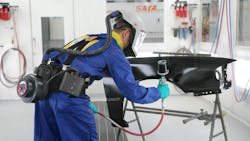Today’s shops can turn to a variety of accessible resources for help in applying finishes and to turn out quality painters. I-CAR can assist with training, as can every paint manufacturer. Help is available in-shop and online. Paint manufacturers regularly send out updates and information sheets.
Yet, shops find themselves having to address application problems. The source of these issues is probably not what you think. Accurate mixing, understanding flash times and correct spraying technique can be challenging, but they aren’t the main source of application problems. The major causes, according to paint manufacturers, typically are what they’ve always been, the basics with a few more contemporary problems tossed in. From skipped application steps to poor prep work and then to rushed processes, many shops struggle to apply finishes that manufacturers have specifically engineered to (1) be easy to use and (2) to provide an OEM quality every time.
The good news is that all these problems can be rather easily addressed. Use the following five steps from experts in the automotive finish industry to avoid application mistakes, satisfy your customers consistently, and put some revenue back into your pocket.
Step 1: Always be as clean as possible.
With contamination of the vehicle’s surface being one of the most prevalent causes of finish problems, one would think keeping vehicles clean would remain a priority for shops. Unfortunately, according to the manufacturer reps ABRN spoke to, this is simply not the case. “Contamination is prevalent because manufacturers overlook two things,” PPG says. “That would be maintenance of the paint wash and not giving the vehicle a simple wash as soon as you get the keys.” That simple wash includes applying a degreaser on the tires, using other appropriate cleaners, and wearing gloves. Skipping this basic step makes keeping the vehicle clean throughout the repair even more difficult and creates other problems, such as the deposit of dust in paint booths that may already be suffering from ventilation issues.
Greg Askew, technical services specialist at AkzoNobel, also says contamination related to a lack of cleaning remains a widespread problem. Askew says cleaning is often overlooked because shops feel rushed to meet production goals. “They unconsciously shortcut things that may not seem as important as they should be,” he says. “But every step in a repair is critical, and not spending an extra 45 seconds cleaning something could create a flaw that takes significant time to fix.”
Askew adds, “Sometimes you have to slow down to speed up. Painters just aren’t getting the message about cleaning. We’re still seeing workers using solvent-based cleaners on waterborne finishes because they never moved off those products and still see their fellow painters using them.”
Step 2: Target bumpers.
With contamination, not adequately prepping plastic bumpers is a major problem. In fact, BASF Application Manager Bill Bierie says the most prevalent issue he sees is bumper peeling. “We have an entire department that deals with application complaints, and 80 percent of that has to do with bumper peeling,” says Bierie. “That has to do with prep. Shops have to properly identify the primer on replacement bumpers.” Bierie notes that aftermarket bumpers make this step even more of a challenge since they often arrive with inadequate primers. “Most are not good,” he says. BASF recommends all solvents be tested and shops should remove those that fail,” he says.
PPG similarly reports issues with bumpers, namely that some arrive raw (no primer). For those with inadequate primers, PPG says the solution can be to remove the primer to produce a raw surface, then apply the appropriate adhesion promoter.
Step 3: Stick to system products.
Paint manufacturers invest significant resources into creating full refinishing systems with a host of products carefully engineered to work together from the moment a vehicle is cleaned and prepped through the time applications are applied and then completed. Many shops, however, are too willing to insert other products (sometimes from other manufacturers) into these systems to either cut costs or, they believe, to reduce application times.
“Systems are designed to work as systems,” explains Askew. “In the Sikkens systems, every product in that system needs to be in that process. They’re tested and verified to work that way, and mixing in other products can be disastrous.” Further, Askew notes that improper choices in hardeners, reducers and additives (along with spraying issues) account for 20 of the 28 sources of paint defects AkzoNobel encounters. Many of these problems could be avoided if shops tried a bit harder to stay informed. Askew notes that manufacturers want to help; in fact, they’re anxious to assist. “We provide data sheets and have entire teams of people who are there to help with our products,” he says.
While some shops may believe they can simply swap in other products as they see fit based on their own expertise or that the processes manufacturers recommend are overly complicated, Askew says both views are inaccurate and dangerous. “Shops need to understand that we as a paint manufacturer have taken into consideration everything needed for a great repair – like efficiency. We’re not trying to make things harder on you,” Askew declares. “Trust in the paint manufacturer and the instructions they put together is the key. The instructions are there for a reason – and it’s for a shop’s success.”
If you’re curious what products are being swapped in, often they’re activators or reducers shops hope will speed application times. But if they’re not part of a system, they can have the opposite effect, sometimes in cases where shops are rushing and overlook concerns such as application climate. Normand Cormier, Axalta training manager for North America and Latin America, explains that shops often go with faster activators and reducers without understanding that during summer or in drier conditions, heat causes the activator to work too fast, causing finish applications to dry too quickly and painters to make too many coat overlaps. Painters end up applying more product than they need, which takes longer to dry. “With a proper activator, the product has a chance to get flat, and you can use a thinner layer that dries faster,” Cormier says.
Step 4: Use spray guns per recommendations.
Cormier goes on to note that many times shops make similar mistakes with properly using their spray guns, employing practices that defy recommendations and produce mistakes. Here, he says, the most common mistake made by painters is spraying at excessive air pressure. “What happens is that you’re left with droplet size that might be too small or an airflow that will move what you’re laying down,” he says.
What’s more, some shops continue to turn to an old and inaccurate method to adjust their guns. “They do it by sound,” Cormier says. “In ten years of testing these guns, I’ve never found one adjusted correctly. Some are way off.” Cormier says shops need to discard all these practices and instead follow recommendations from spray gun and paint manufacturers. In the case of the latter, recommendations are going to differ from one product or coat to the next.
PPG points to other spray gun issues that must be attended to. This includes not only matching colors but textures as well. PPG says painters need to avoid painting flat panels such as hoods “too slick” and to avoid painting parts like doors flat when they need to be positioned up like they sit on the car. Ultimately, the paint job must match the application the OEM provided.
One more spray issue PPG throws in is the state of body filler products used in the repair that are sent to the paint department. Body techs often work quickly and leave pitted fillers that still need to be prepped. Painters and preppers often overlook such flaws after assuming the body techs applied them correctly. If they’re painted over, the pits create the need for expensive rework. PPG says nearly every shop struggles with this issue and recommends businesses work out standard operating procedures between techs and the paint department to ensure fillers are applied and correctly prepared for painting.
Step 5. Regularly train everyone in the paint department.
Training is, of course, at the top of solutions for any problems in the collision repair industry. More than ever, paint manufacturers are making training more easily accessible – for everyone in the paint department. That’s important since bad repair information is everywhere. PPG notes that on social media outlets like YouTube, so-called “experts” routinely post videos on painting that simply aren’t true (such as those who claim alcohol can be mixed with waterborne paints) and ignore the vital set of prep and application steps needed to produce a quality finish. PPG now requires certification for shops who want the manufacturer to warranty its finishes. The company pays to repair a faulty finish if its products were correctly used instead of the shop.
Bierie says preppers need to be included in training, too, since too often they have the least experience of anyone working in a shop and are subject to getting bad information from others. BASF has created online courses for preppers that are set to 15-minute increments so they can be taken while the employee is on break or at lunch. Bierie says painters need to be regularly reminded that technology in the industry is continually updated, and painters need to adapt. “Sometimes you’re dealing with folks with 30 years of muscle memory who are still focused on what they learned about solvent-based paints. That has to change,” he says.
Some shops still, however, balk at the expense and time invested in training that takes painters out of the shop. Bierie says the time is worth it. He notes that high-performing shops understand that the time used to prevent application issues is rewarded with greater production and revenue.
Ultimately, that proper use of time is what solves the application error conundrum. A little more time invested in learning, acting properly, working correctly, aiming for accuracy and striving for improvement at the front end of the painting process heads off the application errors that bedevil so much of the industry. There’s plenty of help available from paint manufacturers and other experts to make the changes you need to be profitable and efficient. That all starts with a simple request for help.
About the Author

Tim Sramcik
Tim Sramcik began writing for ABRN over 20 years ago. He has produced numerous news, technical and feature articles covering virtually every aspect of the collision repair market. In 2004, the American Society of Business Publication Editors recognized his work with two awards. Sramcik also has written extensively for Motor Age and Aftermarket Business World. Connect with Sramcik on LinkedIn and see more of his work on Muck Rack.
